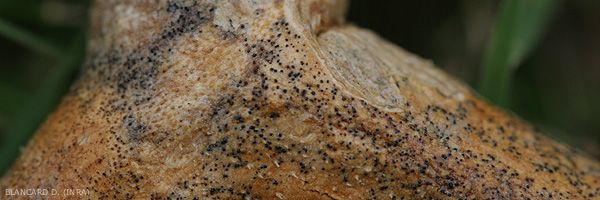
Macrophomina phaseolina (Tassi) Goid., (1947)
Charcoal rot
- Classification: Fungi, Basidiomycota, Incertae_sedis_, Incertae_sedis_, Incertae_sedis_, Incertae_sedis_;
- téléomorphe : Botryosphaeriaceae
- synonymy: Rhizoctonia bataticola (Taubenh.) EJ Butler, (1925)
- English name: charcoal rot
This telluric * fungus, very polyphagous (more than 500 known hosts), with rather limited saprophytic potential, would be an optional parasite appreciating high temperatures. It is present in many countries where Cucurbitaceae are cultivated and affects several species, including melon . It is mainly active in hot, tropical and temperate production areas.
In France , we observed it very occasionally on melon plants cultivated in the southwest, in particular associated with superficial lesions on the lower part of the stem, and with root lesions often in complex with other fungi.
* It should be noted that several fungi, alone or in complexes (this varying according to the production zones and the plots), have been associated in the world (Japan, Israel, Spain, Italy, USA ) with wilting and collapse of melon plants (vine decline, vine collapse), accompanied by lesions and root rots. Among the most frequent are: Acremonium cucurbitacearum (syn. Nodulisporium melonis , now called Plectosphaerella melonis ), Macrophomina phaseolina , Monosporascus connonballus , Pyrenochaeta lycopersici , Pythium spp., Rhizoctonia solani , Rhizopycnis ...





